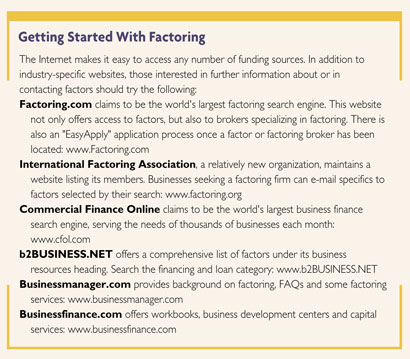
Factoring On-Line And Off
Factoring can provide textile companies with cash flow to weather drawn-out cash-flow
cycles. Psst! Want to sell your textile or apparel business accounts receivable In return
for your outstanding receivables and potential collection problems, your textile or apparel
operation can receive badly-needed cash. Almost instant cash, no collection hassles, and it can all
be accomplished via your computer.For an industry with a gross volume in this country of between
$85 and $100 billion, factoring remains an often-misunderstood and under- utilized strategy for
increasing any textile or apparel business working capital. At its most basic, factoring is the
process of selling all or a portion of a business accounts receivable at a discounted rate from the
face value, in exchange for cash. Factoring companies exist as divisions within many banks, as
divisions of large financial institutions and as small- to mid-sized independently owned finance
companies, as well as services offered by individuals who may dabble in the business. However,
unlike banking services, factors in the United States are relatively free of government regulation
at both the state and federal levels, which may account for their proliferation on the
Internet. Accounts Receivable FinancingMike Burns, assistant vice president of Feather River
State Bank in Marysville, Calif., claims that factoring infuses new life into cash-starved
companies. The time lag between product sales and received payments often puts the biggest strain
on businesses. Rapidly growing startups; manufacturing firms; and service companies without track
records, collateral or personal resources are often unable to obtain the traditional financing they
need to weather drawn-out cash-flow cycles common to their industries. These businesses, according
to Burns, are prime candidates for factoring.Factors measure the viability of a textile or apparel
business by the strength of its accounts receivable and the quality of its product or service not
by financial ratios, equity, profitability or years in business, as many banks do. In other words,
factors look at what you do, how well you do it and the financial strength of those to whom you
sell.Factoring works this way: the factor purchases the operations invoices, typically advancing
the operation about 80 cents on the dollar while holding 20 cents in reserve. After the factor
collects a receivable payment for its customer, it gives you, the operation/customer an additional
15 cents to 18 cents on the dollar and pockets the two- to five-cent difference.Factoring is not
the most affordable type of financing. Even Ken Trombley, assistant vice president at Butte
Community Bank of Orville, Calif., has wondered why more banks havent entered the field. According
to Trombley, most of my other commercial loans yield about 9.5 percent. Factoring gives us a yield
of about 18.5 percent.Using the services of a factor can best be compared to accepting credit cards
for payments. When a store accepts a credit card purchase, it is essentially selling the account
receivable due from the customer to the credit card company for a discount. The credit card company
immediately wires payment for the purchase to the store and assumes the responsibility of
collection.Factoring is a commercial credit card that gives a company the ability to sell its
receivables to a factor in return for immediate funds, albeit at a bigger discount than that
imposed by credit card companies.When deciding whether factoring is for your textile or apparel
business, you must consider the advantages of having immediate access to the cash tied up in your
accounts receivable.Factoring may make sense for a cash-strapped business or one that can utilize
its tied-up cash for expansion or profit taking.Because there are less expensive methods of
financing your textile or apparel business, you must also assess your ability to obtain financing
from your bank or other sources. If your bank provides sufficient funding at acceptable terms, the
need for and benefits from factoring are severely reduced. Financing, Services At A
PremiumMany textile and apparel business owners use factoring until they can obtain bank financing
because, as mentioned, unlike the bank, a factor places most of its emphasis on the quality of the
business work and the financial stability of its customers.Factoring does have its price, but a
good factor will be able to see an offset of its fees with projections of increased profits. Your
factor should be able to show you the cost benefits of factoring and accept only those clients that
will benefit from an immediate increase in cash flow.Choosing a factoring company that fits your
needs can be confusing. To completely understand the services being offered by the factor, you
should examine its website or question its representative at length. What To Expect From A
FactorFirst and foremost, the factor provides a reliable source of cash flow into your business
with a consistent and quick turnaround on invoices to be funded. But that factor should also be
supplementing the efforts of your operations in-house accounts-receivable department by being a
third-party accounts-receivable management firm. Surprisingly, many factors will allow you to
handle your own collections in order to preserve your relationship with the customer. Others,
particularly banks, use a lockbox system, in which all payments are sent to a box that can only be
opened by the factoring bank. Thus, many of the business customers may be unaware that a third
party is involved in the payment or collection process.Going one step further, many factors verify
shipment arrivals, provide detailed aging and collection reports, make collection calls and process
lockbox collections. In addition, a good factor will provide supplier payment guarantees and
pre-award financial commitment letters and credit reviews on current and potential customers. Once
a business has signed up with a factor, a process that today many executives initiate on-line, it
can expect a turnaround time of as little as 24 hours between the submission of the account
receivable until payment is wired or transferred by the factor to the business.Turnaround time is
generally three to five days for issuing bonds or those financial commitment letters that are often
required in some bidding situations.The sheer volume of services provided by some factors is an
excellent reason for any executive to shop around. What services will best benefit your particular
operation Services offered by factors can include:no or one-time sign-up fee;no minimums or startup
costs;no volume guarantees;fast funding turnaround;extensive customer credit reviews;assumption of
all risk; andassistance obtaining traditional bank financing.Cash-flow management is one of the
most important things any textile and apparel business can do to grow. Funds provided through
factoring create a solid, dependable cash flow.When choosing a factor, remember that your factor
will be an integral part of your company. Working on a weekly and/or daily basis as you arrange
financing, the right factor is more than an invoice discount house for your textile and apparel
operation. It becomes a member of your team, working to improve and grow your business.

Editors note: Mark E. Battersby is a tax and financial advisor from Ardmore, Pa. He writes a
weekly farm taxes column syndicated in 45 newspapers and a topical tax column carried by several
trade magazines and more than 25 business publications.
May 2001




